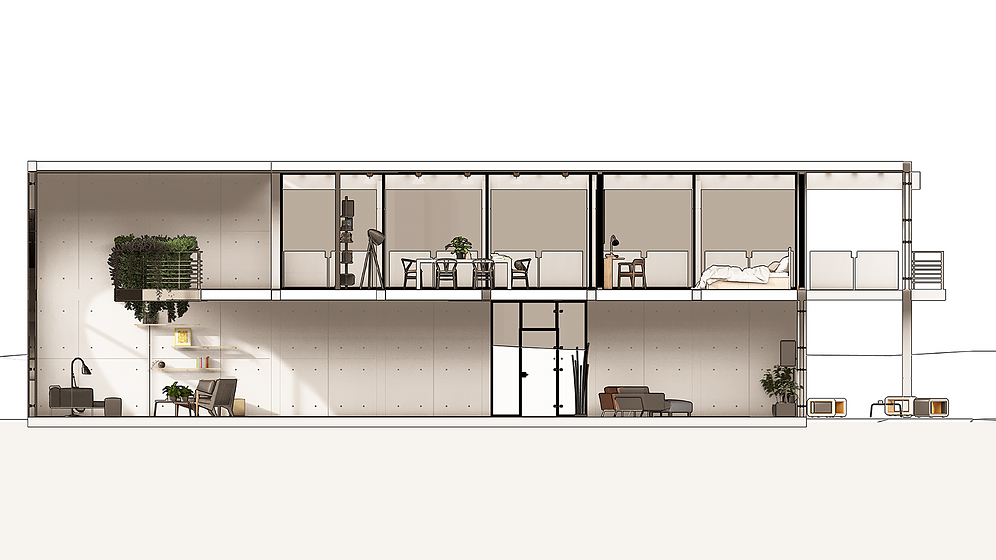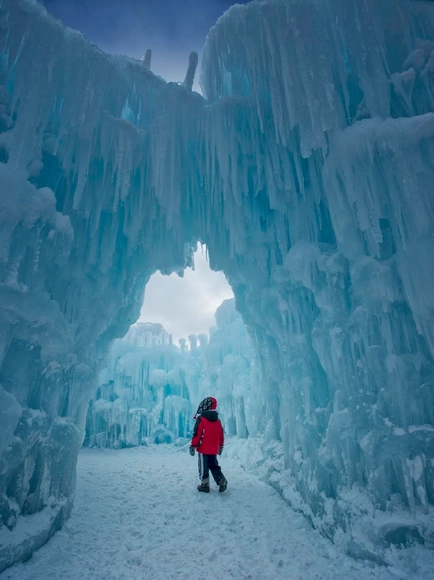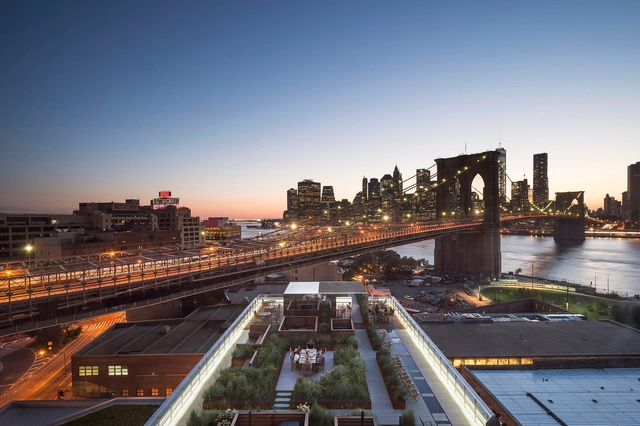
Produce personalized presentation boards that distill complex concepts into simple visual representations with a few helpful tools and effects.


Produce personalized presentation boards that distill complex concepts into simple visual representations with a few helpful tools and effects.

For the past several years, there’s been increasing talk of a renaissance in timber construction. Although we are predisposed to thinking of wood as a component limited to the classic balloon-frame house, new technologies have generated alternative materials which look like and are created from wood, but are stronger and more versatile than their more traditional cousins. While there are a number of different products on the market, including Glulam and Laminated Veneer Lumber (LVL), the material that seems to hold the most promise for changing construction is Cross Laminated Timber (CLT).
The engineered material is created by stacking and gluing smaller pieces of structural lumber, each layer perpendicular to the one below it, to create wooden panels with a number of advantages to other commercial construction materials. According to Reinhard Sauter, owner of Sauter Timber, “CLT has excellent seismic values, it is extremely durable, competitive in price to steel and concrete, lighter and thinner than the latter, and with reduced construction times” - all of which made it an obvious material candidate for the company’s award-winning construction facility in Rockwood, Tennessee, completed in 2014. The structure, which was built with a Glulam frame and CLT wall and roof panels, offers an insight into how these materials can be effectively utilized in future commercial and industrial structures.

Architectural design office UNK project has won a competition to design the Atomic Energy Pavilion in Moscow’s Exhibition of Achievements of National Economy (VDNH), an area that has been in the process of redevelopment and growth since 2013. The pavilion aims to share the “history of the native nuclear industry” and its “contribution into modern economic development," according to competition organizer ROSATOM.
Of the six competition entries to advance to the final stage, the UNK project design, was the only that “decided not to pursue the literal associations with the atom and atomic energy in the hardware of the pavilion, but rather dispersed it in its software," according to the architects.

Coming off of a weekend of brutally cold temperatures in the Northeastern United States, the praising of ice might strike some as disagreeable. But seeing the aqueous creations of the Utah based Ice Castles makes a persuasive case for enduring winter’s wrath. Using a patented system, the company designs ice constructions formed through an additive process in which a substructure of icicle lattices are sprayed with liquid water, resulting in grand formations with the appearance of stalactites or sublimating gases frozen in time.
Seasonally, in four cold-climate locations in North America, the company creates castles of varying sizes that are built over the course of three to four weeks and maintained for approximately six to eight weeks thereafter. What may seem like a simple activity – after all, it’s just ice and water – is actually a complex orchestration, not unlike more traditional architecture, which involves the careful consideration of a number of strategic and site-specific factors.

James Corner Field Operations has completed a nearly 6,000 square foot rooftop garden located in the heart of the DUMBO neighborhood in Brooklyn. The garden is located on top of a seventeen-story apartment complex designed by Leeser Architecture and developed by Two Trees Management. The Dock Street Rooftop Terrace allows residents to view the panoramic scenery of the Brooklyn Bridge, Manhattan Bridge, East River, and Manhattan Skyline.

Jestico + Whiles, in collaboration with developer Carillion, has won planning consent from the Leeds City Council for the Tower Works redevelopment, a competition they won in March of last year. The site is located in the Holbeck Urban Village, which is situated near the Leeds-Liverpool canal. The design incorporates the styles of surrounding buildings, particularly the three Italianate towers, which date back to the industrial revolution.

In an exclusive thirty minute-long discussion with Kevin Roche, described in this interview as "arguably the greatest living architect you've never heard of," Monocle's Steve Bloomfield hears about his early years in practice through to the evolution of his design philosophy over a career which has spanned five decades.


The Southern California Institute of Architecture (SCI-Arc) has announced the launch of SCI-Arc Mexico, to begin in mid-March 2016. Located in the Barragán Foundation in Mexico City, SCI-Arc Mexico will feature international studios, exhibitions, conferences and symposia, furthering SCI-Arc’s global presence by complementing SCI-Arc Shanghai as well as bolstering further development into South America and Europe.

Exterior construction has almost wrapped up on MVRDV’s Chongwenmen M-Cube shopping center in Beijing, featuring a shimmering façade that changes color from grey to pearlescent. The approximately 40,000 square meter center sits in the central Chongwenmen district, just moments from the Forbidden City, and will serve as a centralized hub for retail, cuisine and leisure. The project is set to be completed in summer of this year.
Moon Hoon, an architect based in Seoul’s Gangnam district, created a series of fantastical, detailed “doodles” for the Chicago Architecture Biennial. Titled Doodle Constructivism, his installation is a powerful display of architectural illustration that merges widely contrasting ideas such as peaceful urbanism with mayhem. In his Shelfish Architecture drawing, he creates a sort of housing structure, which looks like a cross between an apartment building, a mushroom, and an alien.

BPD Marignan and XTU Architects, in association with SNI Group and MU Architecture, have won the Réinventer.Paris competition for Paris Rive Gauche site M5A2. The winning project, called In Vivo, seeks to “[promote] social mix and openness between citizens and [integrate] nature into cities, to achieve a fairer, more sustainable, and resilient city,” through three buildings for humans, and one to raise earthworms for vermicomposting of inhabitants’ organic waste.

The American Institute of Architects (AIA) 2016 Jury of Fellows has elevated 149 AIA members and eight international architects to its prestigious College of fellows, an honor awarded to members who have made significant contributions to the profession.
“The Fellowship program was developed to elevate those architects who have made a significant contribution to architecture and society and who have achieved a standard of excellence in the profession. Election to fellowship not only recognizes the achievements of architects as individuals, but also their significant contribution to architecture and society on a national level.”
Some of the elevated members are:

Argentina has unveiled the theme of its national pavilion for the 2016 Venice Biennale: “experimentAR, poéticas desde la frontera” (to experience, poetry from the border). The pavilion will be curated by Atilio Pentimalli with Alejandro Vaca Bononato as the head of artistic direction.

London-based firm Carmody Groarke has been selected to design a standalone hotel suite on Burgh Island, a tidal island on the South Devon coast. Commissioned by Burgh Island Ltd, the owners of the site's eponymous Grade-II listed art deco hotel, the new standalone "Pool House" suite sits atop the island's cliffs offering customers generous views of the Bantham Estuary and the hotel’s Mermaid Pool, an outdoor seawater pool and private beach for hotel guests.

The Curonian Spit in Lithuania contains six main villages: Smiltynė, Alksnynė, Juodkrantė, Pervalka, Preila and Nida, all connected by a single narrow road surrounded by water on both sides. As such, buses are the only public transportation that can connect all six villages. As part of an annual seminar to elevate the architecture of the Curonian Spit, a series of 5 bus stops, within the Neringa region of the spit, have been planned for construction. Specifically chosen to improve the cultural and social function of a typical piece of infrastructure, each bus stop uniquely elevates the qualities of the village it will be built for. See the five planned stops after the break.

Fashion and architecture often intersect, with OMA/AMO designing runways for Prada, and architects, such as Zaha Hadid, designing swimwear and shoes. This time, we’ve rounded up four designers who have created jewelry lines inspired by the built world around them. From cityscape and protractor rings to wearable sculptures, check out the collections after the break.
Part street furniture, part data visualization, Guto Requena’s “I am” installation in São Paulo invited passers-by to interact with the city and connect with one another. Observers were asked to sit on a bench and take a picture of themselves, while also selecting which of six emotions they were feeling at the time: love, joy, surprise, anger, fear or sadness.
Each emotion was associated with a color through which the photo was filtered before appearing on the main façade of the FIESP Building along Paulista Avenue. The images then faded into a graph to colorfully display the predominant emotions at the moment.

SelgasCano's Louisiana Hamlet Pavilion, designed in collaboration with Helloeverything, has been dismantled from its Copenhagen home and is set to be reconstructed in the sprawling Kibera slum, Nairobi, where it will begin a new life as a school. The structure, which is in transit to one of the largest slums in the country, will replace a dilapidated shelter which currently houses 600 pupils. The pavilion, originally commissioned by the Louisiana Museum of Modern Art (Copenhagen), has been relocated following discussions between Iwan Baan, SelgasCano, the museum, and Second Home.

An image of Ismael Levya Architects' transformation of a six-story parking garage in New York City's Upper East Side has been revealed. The project, already under construction, will expand the structure into a 19-story residential tower that will house 56 luxury apartments. Described as a "lantern," the 210-foot-tall building was designed as "four distinct townhouse volumes with metal and glass."

Architecture serves many essential functions in the fabric of the built environment, but it is the perpetual deficit of housing that some might argue is the field’s ultimate clarion call. In virtually every global city, growing populations and limited supplies of affordable dwellings are the major issues of twenty-first century life—and therefore are indications of the continued relevance of architecture in solving vexing urban predicaments. The last century offered early promise in addressing such issues with proposals to house the masses in immense slabs and box buildings, structures almost as large as their social ambition. But what became an asset of scale overlooked, or more probably misunderstood, the social degradation that such largeness elicited.
Aware of the fact that a one-size-fits-all approach to social housing rarely brings the desired outcomes of sociability, accountability, and community, Winnipeg’s 5468796 Architecture sought to reinvent the typology on a smaller scale. The outcome, a project in Winnipeg’s Central Park neighborhood known as Centre Village, is a 25-unit housing complex that prioritizes windows for observation and public spaces for socializing. Initially heralded as a beacon for public housing done right, the project was recently the target of vitriol in a Guardian article, claiming its secluded courtyard makes it "a magnet for drinking and drug-taking" and that its architectural vanity is to the detriment of apartment sizes and layouts. Subsequently, the Winnipeg Free Press published a response piece, "Building a better neighbourhood," and more recently on ArchDaily, 5468796 published a “letter-to-the-editor” to share their side of story and to dispel some of the negativity surrounding Centre Village. The myriad of perspectives can make you wonder: who’s right?

From heart-shaped plans to sweet "buttresses," we're really feelin' the love! Out of over 250 submissions to our Valentine contest, these are our favorites. (Beware, puns ahead!)
In the latest edition of The Urbanist, Monocle 24's weekly "guide to making better cities," the team revisit the theme of heritage, asking why we should "learn to cherish the history of our cities." They visit one of the world's oldest medinas in Tunis, Tunisia, and explore some of the Austrian capital's less than charming Listed buildings, before asking whether or not the quintessential British terraced (row) house is still a cultural icon.

Collective–LOK's Heart of Hearts installation has officially opened in New York City's Times Square, just in time for Valentine's Day. Winner of this year's annual Times Square Valentine Heart Design, a competition curated by the Center for Architecture, the "faceted ring of 12 golden, mirrored hearts" will remain on view in Duffy Square through March 6.

The Lisbon Architecture Triennale has announced the list of 14 Associated Projects that will be included in the upcoming 4th edition, The Form of Form. The projects were selected from 73 proposals, 29 of which were from international participants. "These 14 events will expand the main program and present captivating ideas on venues that highlight the diversity of Lisbon's landscape," noted chief curator André Tavares.
Aiming to "stimulate and deepen the debate around a large spectrum of contemporary views on today's architectural practice," Form of Form seeks to "highlight currents of thought important for the production of architecture in a social context in constant transformation."
The 14 Associated Projects to be featured are:

“Concrete has the ability to be primitive and technological, massive and levitating, to combine the properties of steel with those of mud,” says Rowan Moore in his list of The 10 best concrete buildings created for The Guardian. Through examples spanning three continents, Moore unites old standbys with unexpected wonders, all of which show the varied possibilities inherent in mixing water, aggregate, and cement. In a list that incorporates examples from Classical times to the present, Moore establishes concrete’s unique ability to adapt to different times, styles, applications, and treatments.
Examples by Le Corbusier, Álvaro Siza, Lina Bo Bardi, and Marcel Breuer demonstrate that concrete is anything but workaday or utilitarian. Moore’s list affirms that a material simultaneously strong and light, durable, sustainable, and fire-resistant, can scarcely be considered anything short of miraculous. Of course, ten buildings can only provide an abridged version of concrete’s possibilities, and Moore cheekily apologizes for some of the obvious omissions. Check out the full list here.